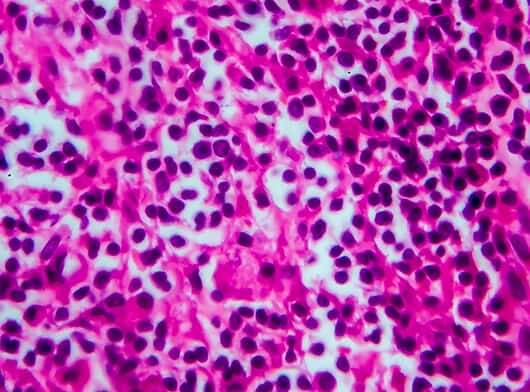The impact non-Hodgkin lymphoma has on a patient depends largely on the type of the disease and the type of treatment prescribed. Because lymphoma affects B cells or T cells, it may make it difficult for a patient to fight off infection.
Some cases of indolent, or slow-growing, lymphoma require only active surveillance and no immediate treatment. Other cases require aggressive treatment, such as high-dose chemotherapy and stem cell transplantation. These types of treatments often cause side effects, such as nausea, weight loss and a compromised immune system. Because lymphoma affects the lymphatic system, another symptom of non-Hodgkin lymphoma that may occur is lymphedema, which is swelling caused by a buildup of lymphatic fluid.
Non-Hodgkin lymphoma has dozens of types and subtypes, each depending on whether cancer started in B lymphocytes or T lymphocytes, which are white blood cells that help the body fight off disease. Most cases of non-Hodgkin lymphomas are B-cell lymphomas. Lymphomas are also characterized by how aggressive (fast-growing) or how indolent (slow-growing) they are. Diffuse large B-cell lymphoma, considered an aggressive lymphoma, is the most common form of non-Hodgkin lymphoma.
Leukemic cells are more likely to remain in the blood and circulate throughout the body. Lymphoma cells may also circulate, but they are more likely than leukemic cells to develop solid tumours in the lymph system, such as in lymph nodes or the spleen.
- Staging is a way of describing where the cancer is located, if or where it has spread, and whether it is affecting other parts of the body. There are 4 stages for NHL: stages I through IV (1 through 4).
- As explained in Symptoms and Signs, each stage may also be further divided into “A” and “B” categories, based on whether or not the person is experiencing specific B symptoms.
-
Stage I: The lymphoma is found in 1 lymph node region. Or, the lymphoma has invaded 1 extra lymphatic organ or site (identified using the letter “E”) but not any lymph node regions (stage IE); this is rare in Hodgkin lymphoma.
-
Stage II: Any of the following conditions applies:
-
Stage II: The lymphoma is in 2 or more lymph node regions on the same side of the diaphragm.
- Stage IIE: The lymphoma involves 1 organ and its regional lymph nodes (lymph nodes located near the site of the lymphoma), with or without lymphoma in other lymph node regions on the same side of the diaphragm.
- Stage II bulky: Either stage II or stage IIE applies, plus there is a mass in the chest. The mass is either larger than one-third the diameter of the chest or larger than 10 centimetres (cm). A centimetre is roughly equal to the width of a standard pen or pencil.
-
- Stage III: There is lymphoma in lymph node areas on both sides of the diaphragm, meaning above and below it.
- Stage IV: The lymphoma has spread to 1 or more organs beyond the lymph nodes. Hodgkin lymphoma usually spreads to the liver, bone marrow, or lungs.
Talk with your doctor about all treatment options. The side effects of NHL treatment can often be prevented or managed with the help of your health care team. This is called supportive care or palliative care and is an important part of the overall treatment plan.
Some treatment side effects might last a long time or might not even show up until years after you have finished treatment. These doctor visits are a good time to ask questions and talk about any changes or problems you notice or concerns you have.


